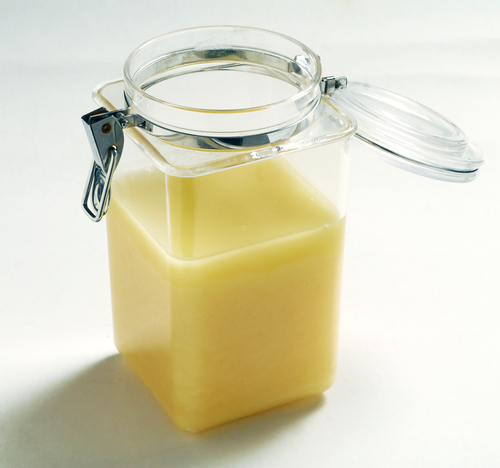Making ghee, or clarified butter, is very straightforward and requires no special equipment. Once you taste fresh homemade ghee, there is no going back to store bought ghee. My mother used to say ‘Pay attention to the ghee when it stops talking to you’. Read on to find out why.
Homemade Ghee
Ingredients
- 32 Oz Unsalted butter
Equipment
- Thick bottomed 2 qt saucepan or dutch oven
- Tea strainer
Instructions
- Add the butter to the pan and heat on medium low. Make sure there is at least 2 inches of headroom above the butter in the pan.
- The butter will gurgle and spit a bit as it melts and the milk solids starts to separate and the water evaporates. Stir every few seconds with a long handled spatula or wooden spoon so you don't get any hot fat flying onto your hand.
- Continue to heat the butter while stirring occasionally until the sizzling starts to taper off and the butter begins to froth. This will take about 5-8 minutes.
- When the butter begins to froth and rise, stir continuously and turn the heat down if the butter seems to be in danger of overflowing the pan. As you stir, make sure you scrape the bottom of the pan and loosen any of the milk solids that are stuck to the bottom. This is to prevent them from burning before the ghee is ready. This stage only lasts for a 15-20 seconds, so make sure you don't leave the ghee unattended.
- When the butter is no longer making any sounds, pay close attention to it and take it off the heat when it turns a light golden brown. It will continue to brown a little bit more with residual heat. If the froth on top of the ghee is making it difficult to tell the color, spoon some of the ghee onto a tablespoon and check the color of melted fat.
- You can now strain the butter mixture using a tea strainer to separate the browned milk solids from the ghee. Discard the milk solids.
- Store the ghee in a storage jar in a cool dark place to prolong its freshness.
Notes
- It is important to use unsalted butter. Ghee made with salted butter will not work for desserts.
- Add a couple of paan leaves, or a stack of curry leaves to the ghee after it froths for an extra flavor kick. Be careful adding the leaves into the hot fat. They will sizzle and splatter ghee for a few seconds.
- Ghee will solidify as it cools, and that is perfectly ok for most recipes.
- If your ghee solidifies before you have had a chance to strain it, just heat it back up until it melts and then strain it.
- Perfectly made ghee will have a grainy texture when it solidifies. Pat yourself on the back if this happens.
- Once you have discarded the browned milk solids, you can pick up all the bits of ghee still left in the pan by adding a cup of hot water to it. Use this ghee infused water to make rice, soups, etc for an extra special ghee flavor.

